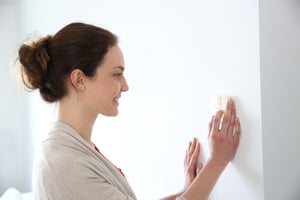
What's the right temperature to set your thermostat? The answer, of course, depends on who you’re asking. Everyone has a different preference when it comes to the temperature of their home — some like it warmer, some like a bit of chill in the air.
That makes finding your perfect home temperature highly personal, and sometimes challenging. Different preferences among family members can sometimes lead to “thermostat wars,” with your home temperature yo-yo-ing up and down.
The trick is to find a happy medium that works for the whole household. And while we can't settle all arguments, we can certainly offer some guidance:
What the Research Says
According to research done by the Helsinki University of Technology, the ideal temperature for productivity is between about 70°F and 72°F. Other research has also shown that the ideal sleeping temperature is between 65°F and 72°F. But when you're talking about your home, it really doesn't matter what the research says. You should set your thermostat where you feel most comfortable.
Recommended Thermostat Settings
For spring and summer settings, many HVAC pros recommend setting your system at 78°F when you’re home. If you expect to be gone four or more hours, consider raising that a high as 88°F. Some experts estimate that you can save as much as six to eight percent off your energy bill for every degree higher than 78°F that you set your system.
For fall and winter temps, pros recommend starting in a range between 68°F and 70°F. Most people will find reasonable comfort somewhere in that range. Experiment a bit and see if you can find a happy medium for the whole family. For those who really like it warmer, a cozy sweater helps. Or, for smaller areas, an electric space heater can add comfort. Just keep in mind that electricity costs more than heating fuel. So, if it’s a larger area that you want warmer, bumping up the thermostat may be the better choice.
Read our Complete Guide to Buying a New Furnace
Then again, all this setting and re-setting can get a little tiresome – and it can add to those family “thermostat wars.” But there are other options.
Programmable Thermostats
The easiest way to manage your home’s temperature is with a programmable or smart thermostat. You can set lower temperatures at night or during the day when you’re not home, and have the house warmed up before you return. Not only can this save on fuel costs, but it can help settle some of those family disagreements about when and how much to adjust the thermostat. Plus, the convenience of being able to adjust temps remotely is a real advantage for busy families.
Interested in learning more about programmable and smart thermostats? Check out our Guide to Choosing the Best WiFi Thermostat.
Special Tips for Setting Your AC
Before you turn on your AC for the season, be sure that the outside temps are consistently above 60°F. Running your air conditioner when the outside temperature is below that can cause major damage to your unit.
“It’s very bad for the unit as it actually works too efficiently and cools the indoor too much,” says Keith Hill, technical support and training manager for Minnesota Air. “The indoor coil will quickly drop below 32°F and then the freezing starts. Frost and ice forms on the coil, blocking the airflow, and if it’s not discovered soon, may lead to compressor damage or even internal failure.”
One of the biggest no-no’s is cranking your AC to a lower temperature just to get your home to cool faster. The Department Of Energy says that doing so “will not cool your home any faster and could result in excessive cooling and unnecessary expense.” Keep the thermostat at your normal, ideal setting and your body will cool normally.
Zone Heating and Cooling
Another way some families manage home temperatures is with zone heating and cooling. Zone heating employs separate thermostats for separate areas, or zones, of the home, so that the temperature in those areas can be controlled separately. While zone heating is most commonly found in new construction homes, more and more homeowners are considering retrofitting portions of their homes with zone heating. Common choices for zones include basements, home additions, or for remote parts of the house that need heating or cooling without causing extreme temps in other areas of the home.
Keep Efficiency in Mind
If all else fails and you do find yourself in the middle of a “thermostat war,” keep in mind that you don't want to frequently change your thermostat temperature more than a couple of degrees either way. If you do, you may be sacrificing efficiency – your HVAC system will have to work extra hard to keep up with frequent changes.
Danny, from Stay Comfy in Minnesota, explains the ideal thermostat setting for maximum efficiency in this video:
Final Tips to Save on Energy
You can save a lot of money on HVAC energy at night. In summer, turn off your AC at night if there is less humidity and cooler temps outside. Open windows and set up a fan to feel the breeze of fresh air. In the cooler months, set your temperature lower and add a blanket or two to stay cozy at night.
When you’re away for the day, turn your AC setting up several degrees. If it’s mild out, you can turn off the AC entirely. During the heating months, set your thermostat a few degrees lower when you’re gone.
When in doubt about setting your thermostat, trust the advice from our expert, Keith: “Thermostat set point is always a matter of personal preference. Within reason, ignore the numbers and set it to your comfort level.”





